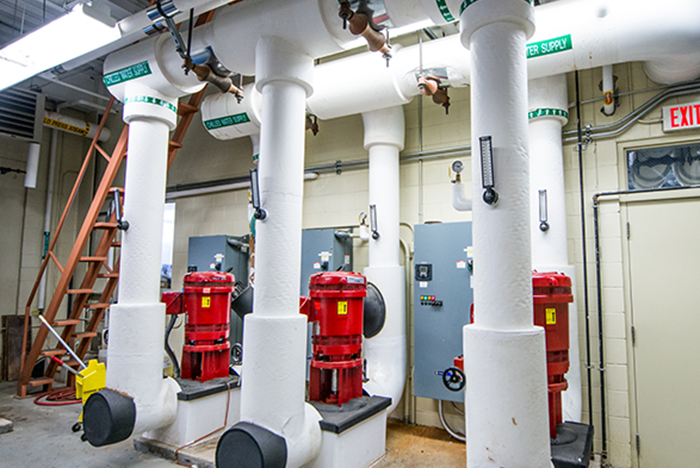Optimizing infrastructure to reduce downtime

Optimizing systems liked chilled water supply can reap financial and efficiency benefits, and create an overall healthier patient care environment.
Image courtesy of American Society for Health Care Engineering
In an era when the integrity of critical infrastructure is paramount, the role of building system solutions cannot be overstated. This is particularly true for industries where the stakes are high and the demand for reliability is nonnegotiable — from health care and energy to data center and educational facilities and more. There are many complexities when it comes to adapting mission-critical infrastructures, but overcoming those challenges and realizing the benefits of doing so are necessary to meet market demands while continuing to drive strategic growth.
The imperative — and benefits — of building optimization
Today, having an efficient and optimized building is not just beneficial; it’s imperative. Building optimization serves as the backbone for enhancing energy efficiency, ensuring health and safety, integrating cutting-edge technology, meeting regulatory standards and providing economic advantages — all while bolstering defenses against unpredictable forces. For mission-critical entities like health care facilities, data centers and even educational institutions, the stakes are even higher. These sectors work diligently to avoid operational pauses, making the seamless design, installation and maintenance of building systems a top priority.
Consider the case of a health care facility undergoing a heating, ventilating and air conditioning (HVAC) system upgrade. The benefits are plentiful and range from meeting regulatory standards to lowering energy costs. In fact, according to ENERGY STAR®, upgrading HVAC systems in health care facilities can reduce energy use by as much as 30%. It estimates that with the widespread adoption of energy-efficient, low-cost measures and cost-effective investments — including upgraded infrastructures — the health care sector could save over $1 billion annually. Other benefits of building upgrades include:
- Improved air quality. Upgraded HVAC systems improve air quality through reducing outside air intake to appropriately measured volumes, displacement ventilation, precise zone pressure control, and by maintaining balanced air systems. In a health care facility, these enhancements would benefit patients and medical staff alike, fostering a healthier environment.
- Regulatory compliance. Regulations mandate specific standards for indoor air quality, energy efficiency and safety. Meeting stringent standards sometimes requires making building system upgrades to mechanical, electrical and plumbing (MEP) and always necessitates routine maintenance to avoid penalties or legal issues.
- Less maintenance, lower costs. Coordinated MEP components prevent inefficiencies and enhance system reliability, minimizing maintenance needs. Additionally, by prioritizing efficiency during design and installing systems simple to maintain, building owners benefit from reduced maintenance expenses and a more sustainable environment.
Best practices and key considerations
Reducing downtime in mission-critical facilities is attainable with the right practices. The key to successfully optimizing building infrastructure lies in meticulous planning and execution, while considering how to best leverage the potential benefits. Below are factors to consider when upgrading and maintaining building systems to reduce downtime:
- Energy modeling. Predictive analytics use historical data and simulations to optimize system design. For instance, modeling HVAC load profiles ensures accurate chiller sizing, while performance alignment ensures compliance with standards like ASHRAE 90.1-2022, Energy Standard for Sites and Buildings Except Low-Rise Residential Buildings, setting minimum requirements for energy-efficient building designs while maintaining occupant comfort.
- Minimizing disruptions. Strategic scheduling goes a long way. For example, performing a major system upgrade during off-peak hours will help prevent complications and interference with operations. Facilities can also consider temporary solutions, like deploying portable HVAC units during system downtime so that critical areas remain operational. When replacing equipment, going like-for-like should not be the default. Instead, complete a load analysis to ensure the appropriate selection is made that optimizes performance and energy usage.
- Testing and commissioning. Functional verification involves thorough testing to make sure all system parts work correctly. An example might be checking that systems utilize the appropriate amount of outside air and that too much of that outside air isn’t used during off-hours. Many older buildings were designed based upon certain conditions and space usage programs that have since changed. Performance adjustments and retrocommissioning are necessary to ensure systems are optimized based upon the current space usage.
- Staff training/augmentation. To make sure buildings run at maximum efficiency, it's important all the maintenance team understand every detail of the MEP system’s operation. This means constant training on both new and existing systems within the facility. In certain buildings, the facilities staff may need to be augmented to provide additional resources. Others may have enough staff to handle maintenance internally. In both cases, the emphasis remains that when these systems are well taken care of, they use less energy and are less likely to break down, saving money and avoiding problems.
- Remote monitoring. Remote monitoring is important for buildings that need to run efficiently all the time, like hospitals or data centers. For example, using Internet of Things sensors means putting in devices that collect data in real time, like checking refrigerant levels in chillers to stop leaks. Automation systems, like building management systems, send alerts before something breaks. For example, if a pump is failing, the system can detect it early to prevent major problems and keep everything running smoothly.
These upgrades and practices enhance reliability, efficiency and compliance, ensuring smooth facility operations even when major changes are underway.
A cornerstone of modern infrastructure management
Building optimization is at the cornerstone of modern infrastructure management, especially for sectors where continuity is essential. Strategic planning and adept execution not only elevate operational excellence but also yield substantial financial returns. As health care faces an increasing demand for sophisticated building systems, embracing these strategies is crucial for sustainable growth and long-term resilience.
Michael M. McCann serves as president, CEO, and director of Limbach, a building systems solution firm based in Warrendale, Pa.




